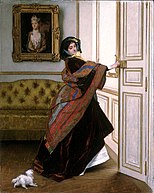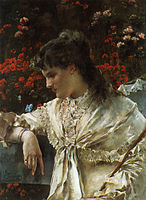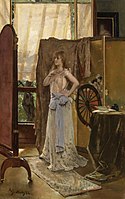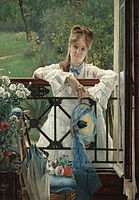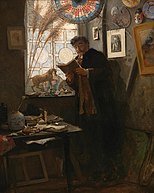Alfred Stevens (painter)
Alfred Stevens | |
|---|---|
Belgian | |
| Known for | Painting |
| Notable work | What is Called Vagrancy, The Psyché, The Parisian Sphinx |
| Movement | Social realism, Realism, Orientalism, Dutch realism style |

Alfred Émile Léopold Stevens (11 May 1823 – 24 August 1906) was a
Family background
Stevens was born in Brussels. He came from a family involved with the visual arts: his older brother Joseph (1816–1892) and his son Léopold (1866–1935) were painters, while another brother Arthur (1825–1899) was an art dealer and critic. His father, who had fought in the Napoleonic wars in the army of William I of the Netherlands, was an art collector who owned several watercolors by Eugène Delacroix, among other artists. His mother's parents ran Café de l'Amitié in Brussels, a meeting place for politicians, writers, and artists. All the Stevens children benefited from the people they met there, and the social skills they acquired in growing up around important people.[1]
Education
After the death of his father in 1837, Stevens left middle school to begin study at the
Career beginnings

Stevens's work was shown publicly for the first time in 1851, when three of his paintings were admitted to the Brussels Salon. He was awarded a third-class medal at the Paris Salon in 1853, and a second-class medal at the
as well as popular cafés.
In 1858, Stevens married Fanny Juliette Albertine Marie Hortense Blanc (1836-1891) who came from a rich Belgian family and old friends of the Stevens's. Eugène Delacroix was a witness at the ceremony.[5] The couple would have four children together—Leopold, Jean, Catherine, and Pierre. Stevens painted his wife's portrait many times, including Memories and Regrets (left). When she died, he wrote that he was "forever inconsolable."
Mature career
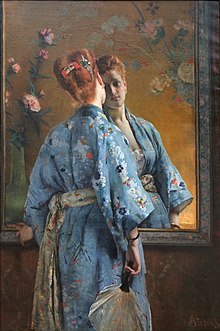

During the 1860s, Stevens became an immensely successful painter, known for his paintings of elegant modern women. His exhibits at the Salons in Paris and Brussels attracted favorable critical attention and buyers. An excellent example of his work during this time is La Dame en Rose or Woman in Pink (
Stevens fought for the French during the siege of Paris in the Franco-Prussian War, but returned to Belgium with his wife and family before the Paris Commune. They returned after the war, and Stevens continued to achieve critical acclaim as well as great success with collectors. In 1875, he bought a grand house and garden in Paris on rue des Martyrs, which appeared in his paintings as well as those of other artists, including Édouard Manet's The Croquet Party (Städel Museum, Frankfurt am Main) from 1873.[6] (He had to leave the house in 1880, however, to make way for the construction of a new street, which was named after him.) In 1878, he was made a Commander of the Legion of Honor and received another first-class medal at the Salon.[citation needed]
Despite earning a considerable income through the sale of his paintings, Stevens found that a combination of bad investments and excessive spending caused him great financial difficulties during the 1880s. An additional expense came from summers by the sea, which a doctor told Stevens in 1880 were essential for his health. Thus the artist was glad to agree when the Paris dealer Georges Petit offered him 50,000 francs to finance his vacation in exchange for the paintings Stevens produced during that time.
Late career
The single most important work from the second half of Stevens's career is the monumental Panorama du Siècle, 1789–1889, which he painted with Henri Gervex. Stevens painted the women and details and Gervex the men, with the help of fifteen assistants.[10] It was shown to great acclaim at the International Exhibition held in Paris in 1889. He also received several great professional tributes. In 1895, a large exhibition of his work was held in Brussels. In 1900, Stevens was honored by the Ecole des Beaux-Arts in Paris with the first retrospective exhibition ever given to a living artist. Supported by patrons led by the Comtesse de Greffulhe, it achieved social cachet as well as popular success. In 1905, he was the only living artist allowed to exhibit in a retrospective show of Belgian art in Brussels. Despite these exhibitions, he was not able to sell enough of his work to manage well financially. Having outlived his brothers and most of his friends, he died in Paris in 1906, living alone in modest rooms, whilst still remaining in touch with his four children.[11]
Honours
- 1881: Grand Officer in the Order of Leopold.[12]
Selected works
-
The Painter and His Model, 1855
-
Will You Go Out With Me Fido?, 1859
-
Lady at a Window Feeding Birds, c. 1859
-
News from Afar, 1860 (Exhibition: "Salute to Belgium, 1980)
-
The Lady in Pink, 1866
-
Lighthouse at Dusk
-
The Parisian Sphinx, 1875–1877
-
The Japanese mask, c. 1877
-
Rêverie, c. 1878
-
Maria Magdalena, 1887
-
The Study of the Role, 1888
-
In the Studio, 1888
-
The New Blue Ribbon, 1894
See also
Notes
- ISBN 978-90-6153-876-9.
- ^ ISBN 978-90-6153-876-9.
- ^ a b c d Thomas, Bernadette. "Alfred (Emile-Léopold) Stevens" in Oxford Art Online. Retrieved 27 December 2013.
- ^ "Musée d'Orsay: Alfred Stevens What is called vagrancy". musee-orsay.fr. 4 February 2009.
- ISBN 978-90-6153-876-9.
- ^ "Willkommen im Newsroom". staedelmuseum.de.
- ISBN 978-90-6153-876-9.
- ISBN 978-0-940979-01-7.
- RKD
- ISBN 978-90-6153-876-9.
- ISBN 978-90-6153-876-9.
- ^ Handelsblad (Het) 15-05-1881
References
- Berko, P. & V. (1981). "Dictionary of Belgian painters born between 1750 & 1875", Knokke, pp. 604–607.
- Berko, P. & V. (2011). "19th Century European Virtuoso Painters", Knokke, p. 516, illustrations pp. 136, 398–399 & 429.
- Derrey-Capon, Danielle (2009). "Between Women and Reflections; Alfred Stevens: a biography (Brussels 1823 – Paris 1906)." In Alfred Stevens, Brussels 1823-Paris 1906. Exh. cat. Brussels/Mercatorfonds: Royal Museums of Fine Arts of Belgium and Amsterdam: Van Gogh Museum. Pp. 11–58.
External links
- RWNAF.org, Alfred Stevens's Biography
- Chisholm, Hugh, ed. (1911). . Encyclopædia Britannica. Vol. 25 (11th ed.). Cambridge University Press. pp. 905–906.


